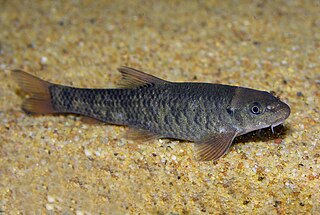
The Brahmaputra, also known as the Yarlung Tsangpo in Tibet, the Siang/Dihang River in Arunachal Pradesh, and Dilao in Assam, is a trans-boundary river which flows through Tibet, China, India, and Bangladesh. It is the 9th largest river in the world by discharge, and the 15th longest.

The Indo-Gangetic Plain, also known as the North Indian River Plain, is a 700-thousand km2 (172-million-acre) fertile plain encompassing northern regions of the Indian subcontinent, including most of northern and eastern India, around half of Pakistan, virtually all of Bangladesh and southern plains of Nepal. The region is named after the Indus and the Ganges rivers and encompasses a number of large urban areas. The plain is bound on the north by the Himalayas, which feed its numerous rivers and are the source of the fertile alluvium deposited across the region by the two river systems. The southern edge of the plain is marked by the Chota Nagpur Plateau. On the west rises the Iranian Plateau. Many developed cities like Kolkata, Delhi, Lahore, Karachi and Dhaka are located in the Indo-Gangetic Plain.

Northeast India is the easternmost region of India representing both a geographic and political administrative division of the country. It comprises eight states – Arunachal Pradesh, Assam, Manipur, Meghalaya, Mizoram, Nagaland, Tripura and Sikkim.

Garra is a genus of fish in the family Cyprinidae. These fish are one example of the "log suckers", sucker-mouthed barbs and other cyprinids commonly kept in aquaria to keep down algae. The doctor fish of Anatolia and the Middle East belongs in this genus. The majority of the more than 140 species of garras are native to Asia, but about one-fifth of the species are from Africa.

Tor putitora, the Putitor mahseer, Himalayan mahseer, or golden mahseer, is an endangered species of cyprinid fish that is found in rapid streams, riverine pools, and lakes in the Himalayan region. Its native range is within the basins of the Indus, Ganges and Brahmaputra rivers. It is a popular gamefish, once believed to be the largest species of mahseer, and can reach up to 2.75 m (9.0 ft) in length and 54 kg (119 lb) in weight, though most caught today are far smaller. It is threatened by habitat loss, habitat degradation and overfishing, and it already has declined by more than an estimated 50%. This omnivorous species is generally found near the surface in water that ranges from 13 to 30 °C (55–86 °F).
Pakke Tiger Reserve, also known as Pakhui Tiger Reserve, is a Project Tiger reserve in the Pakke Kessang district of Arunachal Pradesh in northeastern India. The 862 km2 (333 sq mi) reserve is protected by the Department of Environment and Forest of Arunachal Pradesh. In a notification (CWL/D/26/94/1393-1492) dated Itanagar 19 April 2001, issued by the Principal Secretary, the Governor of Arunachal Pradesh renamed Pakhui Wildlife Sanctuary as Pakke Wildlife Sanctuary Division.
Garra arupi is a species of cyprinid fish in the genus Garra from the upper Brahmaputra basin in Arunachal Pradesh.

The Subansiri River is a trans-Himalayan river and a tributary of the Brahmaputra River that flows through Tibet's Lhünzê County, Shannan Prefecture and the Indian states of Arunachal Pradesh and Assam. The Subansiri is 442 kilometres (275 mi) long, with a drainage basin 32,640 square kilometres (12,600 sq mi). It is the largest tributary of the Brahmaputra contributing 7.92% of the Brahmaputra's total flow.

Securicula gora is a species of cyprinid fish found in Bangladesh, India, Pakistan and possibly in Nepal. It is the only species in its genus.
Garra magnidiscus is a species of cyprinid fish in the genus Garra. Identified in 2013, Garra m. is found in the Upper Siang district of Arunachal Pradesh where is it is known locally as Ngop. The name magnidiscus refers to a distinctive large adhesive disc found in the posterior region of its mouth.

The Bhupen Hazarika Setu, also referred to as the Dhola–Sadiya Bridge, is a beam bridge in India, connecting the northeast states of Assam and Arunachal Pradesh. The bridge spans the Lohit River, a major tributary of the Brahmaputra River, from the village of Dhola in the south to Sadiya to the north. The bridge is the first permanent road connection between the northern Assam and eastern Arunachal Pradesh.

Arunachal Pradesh is primarily a hilly tract nestled in the foothills of the Himalayas in northeast India. It is spread over an area of 83,743 km2 (32,333 sq mi). 98% of the geographical area is land out of which 80% is forest cover; 2% is water. River systems in the region, including those from the higher Himalayas and Patkoi and Arakan Ranges, eventually drain into the Brahmaputra River.
Garra elongata is a species of ray-finned fish in the genus Garra from Manipur in north eastern India and possibly Myanamar.
Garra tamangi is a species of ray-finned fish in the genus Garra described from the Dikrong River at Hoj near NHPC complex, Itanagar, Papum Pare district, Arunachal Pradesh, north eastern India.
Garra alticaputus is a species of cyprinid fish in the genus Garra described from the Dikrong River at Boorum village Itanagar, Arunachal Pradesh, India.
Garra minimus is a species of cyprinid fish in the genus Garra described from the Ranga River, Lower Subansiri District, Arunachal Pradesh, India.
Garra nigricauda is a species of cyprinid fish in the genus Garra which is found in the Brahmaputra River, Arunachal Pradesh, India.
Aborichthys waikhomi is a species of stone loach found in the Noa-Dihing River, upper Brahmaputra basin in the Namdapha National Park and Tiger Reserve in Arunachal Pradesh, India. This fish grows to a length of 6.8 centimetres (2.7 in) SL.
Aborichthys iphipaniensis is a species of stone loach found in the Iphipani River drainage, upper Brahmaputra basin, Arunachal Pradesh, northeastern India. Habitat: freshwater.
Pseudecheneis sirenica is a species of sisorid catfish found in the Siren River of the Brahmaputra river basin in Arunachal Pradesh, India.. This species reaches a length of 15.5 cm (6.1 in).








